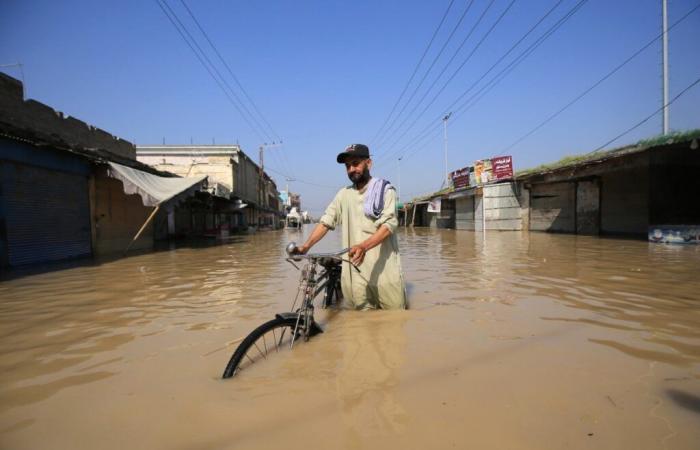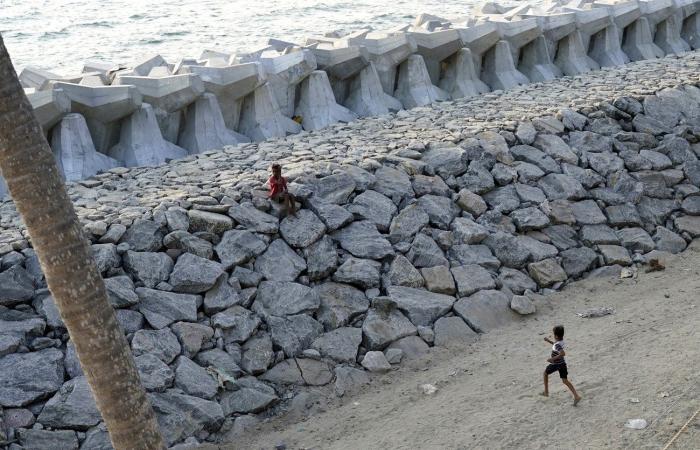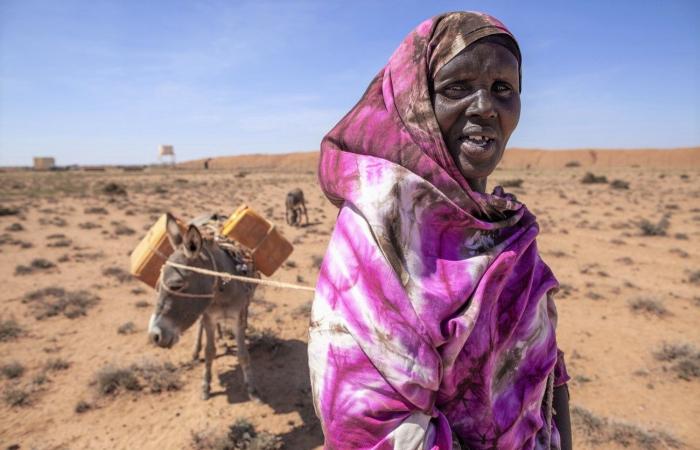Unprecedented floods hit Pakistan’s Khyber Pakhtunkhwa province on August 29, 2022.
EPA/BILAWAL ARBAB
As the UN climate conference (COP29) opens Monday in Baku, Azerbaijan, Switzerland is proposing that developing countries that are large emitters of CO2, such as China and Russia, contribute to financing climate projects in poor countries. This approach is controversial.
This content was published on
November 11, 2024 – 09:19
Replacing a coal-fired power plant with its equivalent based on renewable energies, building dikes against flooding or promoting sustainable agricultural techniques are all essential measures to reduce CO2 emissions and adapt to climate change. The urgency of these interventions is particularly felt in the most vulnerable countries. Countries which, often, have not contributed to the increase in emissions and which do not have the means to act. These are, for example, Pakistan or Somalia.
A question then arises: who should finance the transition to a low-emission society and solutions aimed at greater climate resilience in these countries? The most obvious answer is: the main culprits. So the nations which have released the most greenhouse gases and which have played a leading role in the rise in temperatures. In other words, industrialized countries.
But this vision, shared for decades, is being called into question. The world has changed and countries once responsible for small fractions of global emissions, such as China and Saudi Arabia, are now among the largest emitters of CO2External link. Should these countries also contribute to financing climate projects in poor countries?
Plus
Plus
Want to know more? Subscribe to our newsletter
Subscribe to our newsletter for the Fifth Switzerland and receive our best articles in your inbox every day.
read more Want to know more? Subscribe to our newsletter
This is the question that must be answered by the Conference of the Parties to the United Nations Framework Convention on Climate Change (COP29).External link), in Baku, Azerbaijan, between November 11 and 22. A summit supposed to adopt a new climate financing objectiveExternal linkwhere representatives from nearly 200 countries, including Switzerland, will negotiate around the question of who should contribute out of their own pocket and for what total amount.
Among the proposals on the table is that of SwitzerlandExternal linkthe first country with Canada to present precise criteria to broaden the base of contributing States.
“No one disputes the fact that industrialized countries have a duty to participate in climate financing,” Felix Wertli, Switzerland’s chief negotiator at COP29, assures SWI swissinfo.ch. But we believe that developing countries which today generate a lot of emissions and which have the economic capacity to do so should also contribute.
>> The animation below shows the evolution of CO2 emissions in the main world economies:
External content
Funding that has become insufficient
Adopted in 1992, the United Nations Framework Convention on Climate Change (UNFCCC) defines which countries are required to provide financial assistance to the rest of the planet. These countries – the United States, members of the European Union, Switzerland, Britain, Japan and others – committed in 2009 to $100 billion a year by 2020. Target achieved , but only in 2022.
As the climate crisis intensifies, however, more money has become necessary. According to the United Nations, developing countries require an amount five times higher, or around $500 billion.External link per year, to combat the effects of climate change. An estimate deemed insufficient by India and African states, for whom the total envelope should reach at least 1,000 billion dollars per year.

An example of climate adaptation: a sea wall in the state of Kerala, India.
Copyright 2023 The Associated Press. All Rights Reserved
“The more we expand the list of contributing countries, the higher the total amount of the new objective can be,” argues Felix Wertli. The question is also political. If all countries in a position to do so contribute to this objective, Switzerland and other industrialized nations may be more inclined to increase their funding, knowing that it is a common effort, notes the diplomat.
The European UnionExternal linkthe United States and other industrialized countries share this vision and request the participation of developing countries that have become major emitters of greenhouse gases and enjoy strong economic growth. A claim addressed to ChinaExternal link in particular, which has become the world’s leading emitter.
China, Russia and Gulf States on Swiss list
Switzerland proposes to expand the group of contributing countries based on two models. The first considers the ten states which currently emit the most CO2 and whose gross national income per capita, at purchasing power parity, exceeds $22,000.
A group that would include Saudi Arabia, Russia and China. India, Brazil and Indonesia, which are among the most populous and polluting nations, would be excluded.
The second model takes into account countries whose cumulative emissions reach at least 250 tonnes per capita since 1990 and whose gross national income per capita exceeds 40,000 dollars. A scenario that would include virtually all of the Persian Gulf states – Saudi Arabia, the United Arab Emirates, Qatar, Kuwait and Bahrain – and Singapore, South Korea, Israel, Poland and the Czech Republic.
The Overseas Development Institute (ODI), an independent think tank based in London, comes to a similar conclusionExternal link. Qatar, Singapore and Israel are expected to begin providing financial assistance, according to the ODI.
Plus

Plus
Climate finance: what about international solidarity?
This content was published on
Feb 10 2021
Switzerland and other industrialized countries are not doing enough to help poorer states deal with the climate crisis.
read more Climate finance: what about international solidarity?
Strengths and weaknesses of the proposal
The Swiss proposalExternal link expanding the circle of contributing countries is a “pragmatic response” to the growing urgency of climate action, says Bruce Mecca, of the Climateworks Center at Monash University, Australia. “Its strength lies in the fact that it starts from the principle that climate responsibility should not only fall on traditional contributing countries,” he told SWI swissinfo.ch.
But this approach should not dilute the historical responsibility of the countries that have benefited the most from industrialization based on fossil fuels, emphasizes Brurce Mecca. “There is a risk that richer countries will evade their climate finance obligations by placing an excessive burden on emerging economies like China and Saudi Arabia and potentially on middle-income countries.”
“There is a risk that the richest countries will evade their climate finance obligations by placing an excessive burden on emerging economies.”
Brurce Mecca, Climateworks Centre
For Bertha Argueta, of Germanwatch, an NGO focused on development and the environment, the Swiss model has the advantage of allowing the inclusion of new contributing countries once they have reached established thresholds of emissions and wealth. . “This will avoid having to reopen negotiations in the years to come,” she judges.
This specialist, however, questions Switzerland’s real intention. Many other methodologies, she explains, take into account emissions per capita, which would exclude China. More recent studiesExternal link introduce other relevant factors such as the level of development of the country in question. Bertha Argueta suspects Switzerland of having put together a proposal with potential candidate countries in mind, for political reasons, without openly naming it.
The Swiss proposal has another flaw, according to Imogen Outlaw of the NewClimate Institute. It does not take into account vulnerability to climate change.
Every country should contribute to the goal
What’s more, emerging economies are opposedExternal link any revision of the group of contributing countries. Chinese Foreign Ministry spokesperson Lin Jian saidExternal link that developed countries must assume their historic responsibility in future agreements on climate finance, without shifting this responsibility to developing countries.
Like other emerging economiesExternal linkChina is already financing various projects to abandon fossil fuels and adapt to climate change in other developing countries. But it does so on its own terms, within the framework of South-South cooperation. Between 2013 and 2022, it spent $4.5 billion per yearExternal link on average. In comparison, the Swiss contribution under the UNFCCC amounted to 847 million francs ($970 million) in 2023.
Swiss negotiator Felix Wertli recognizes the financial commitment of China and other developing countries. But he deplores the lack of transparency. “We don’t know if these are strict loans or financing linked to certain requirements.”
A priori, the Swiss proposal has little chance of making it to COP29. But it could increase pressure on certain States by encouraging them to participate on a voluntary basis in public climate financing. And encourage them to transparently communicate their contribution to the United Nations, without renouncing the status of developing countries.
“We are not looking to change the classification of countries,” assures Felix Wertli. We only want all countries to contribute to the new collective financial objective according to their means. This is the only way to reduce emissions and limit global warming to 1.5°C. »
Text proofread and verified by Veronica De Vore, translated from Italian by Pierre-François Besson/dbu









